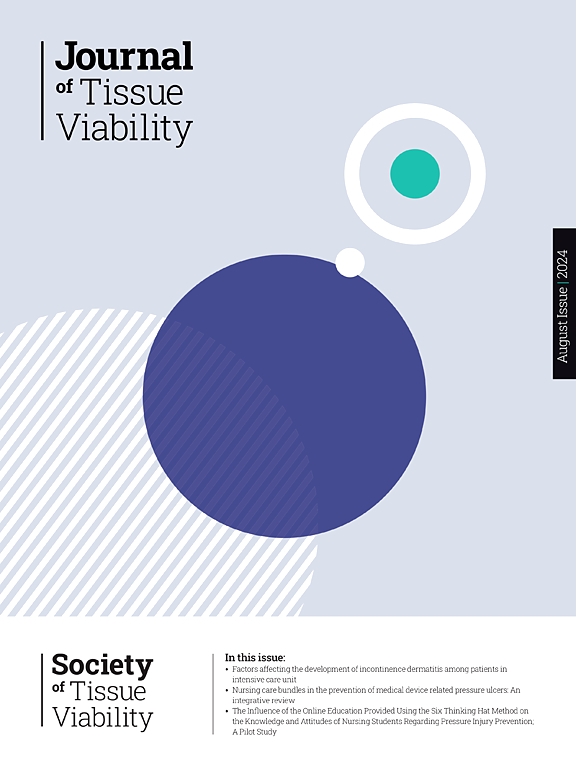Effectiveness of a standardized skin care protocol in reducing incontinence-associated dermatitis among critical care patients: A clinical investigation
IF 2.4
3区 医学
Q2 DERMATOLOGY
引用次数: 0
Abstract
Background
Incontinence-associated dermatitis (IAD) is a common yet preventable skin condition among critically ill patients. Implementing standardized skin care protocols may help reduce its incidence and severity.
Aim
This study aimed to investigate the effectiveness of implementing a standardized skin care protocol in preventing IAD among critically ill patients.
Materials and methods
A quasi-experimental research design adhering to the STROBE guidelines was used. The study was conducted in the intensive care units of a Governmental University Hospital, Egypt. A total of 100 adult critically ill patients were enrolled: 50 in the experimental group, who received the standardized skin care protocol, and 50 in the control group, who received routine skin care. Clinical and demographic data were collected. The study group followed the protocol for seven days. Two tools were used for data collection: Tool 1 involved demographic and clinical data, while Tool 2 included the Perineal Assessment Tool, the Incontinence-Associated Dermatitis Severity Instrument, and the Braden Scale for pressure ulcer risk assessment. Both groups were compared regarding the development of pressure ulcers, their locations, and the incidence of IAD.
Results
Application of the skin care protocol significantly reduced the incidence and severity of IAD in the study group compared to the control group. Significant predictors of increased risk for IAD included age, body mass index, fluid balance, and mean temperature (p ≤ 0.05). Serum albumin was not a significant predictor (p = 0.341).
Conclusion
Implementing a standardized skin care protocol effectively lowered the incidence and severity of IAD in critically ill patients and delayed its development. These findings highlight the importance of evidence-based skin care practices in intensive care settings.
标准化皮肤护理方案在减少重症患者尿失禁相关性皮炎中的有效性:一项临床调查
背景:尿失禁相关性皮炎(IAD)是危重患者中一种常见但可预防的皮肤病。实施标准化的皮肤护理方案可能有助于减少其发病率和严重程度。目的本研究旨在探讨实施标准化皮肤护理方案在预防重症患者IAD中的有效性。材料与方法采用准实验研究设计,遵循STROBE准则。这项研究是在埃及一所政府大学医院的重症监护室进行的。共纳入100例成人危重患者:实验组50例,采用标准化皮肤护理方案;对照组50例,采用常规皮肤护理方案。收集临床和人口统计数据。研究小组遵循该方案7天。两种工具用于数据收集:工具1涉及人口统计学和临床数据,而工具2包括会阴评估工具、失禁相关性皮炎严重程度工具和用于压疮风险评估的Braden量表。比较两组患者压疮的发生情况、部位和IAD的发生率。结果与对照组相比,皮肤护理方案的应用显著降低了IAD的发生率和严重程度。年龄、体重指数、体液平衡和平均体温是IAD风险增加的重要预测因素(p≤0.05)。血清白蛋白不是显著的预测因子(p = 0.341)。结论实施规范的皮肤护理方案可有效降低重症患者IAD的发生率和严重程度,延缓其发展。这些发现强调了重症监护环境中循证皮肤护理实践的重要性。
本文章由计算机程序翻译,如有差异,请以英文原文为准。
求助全文
约1分钟内获得全文
求助全文
来源期刊

Journal of tissue viability
DERMATOLOGY-NURSING
CiteScore
3.80
自引率
16.00%
发文量
110
审稿时长
>12 weeks
期刊介绍:
The Journal of Tissue Viability is the official publication of the Tissue Viability Society and is a quarterly journal concerned with all aspects of the occurrence and treatment of wounds, ulcers and pressure sores including patient care, pain, nutrition, wound healing, research, prevention, mobility, social problems and management.
The Journal particularly encourages papers covering skin and skin wounds but will consider articles that discuss injury in any tissue. Articles that stress the multi-professional nature of tissue viability are especially welcome. We seek to encourage new authors as well as well-established contributors to the field - one aim of the journal is to enable all participants in tissue viability to share information with colleagues.
 求助内容:
求助内容: 应助结果提醒方式:
应助结果提醒方式:


